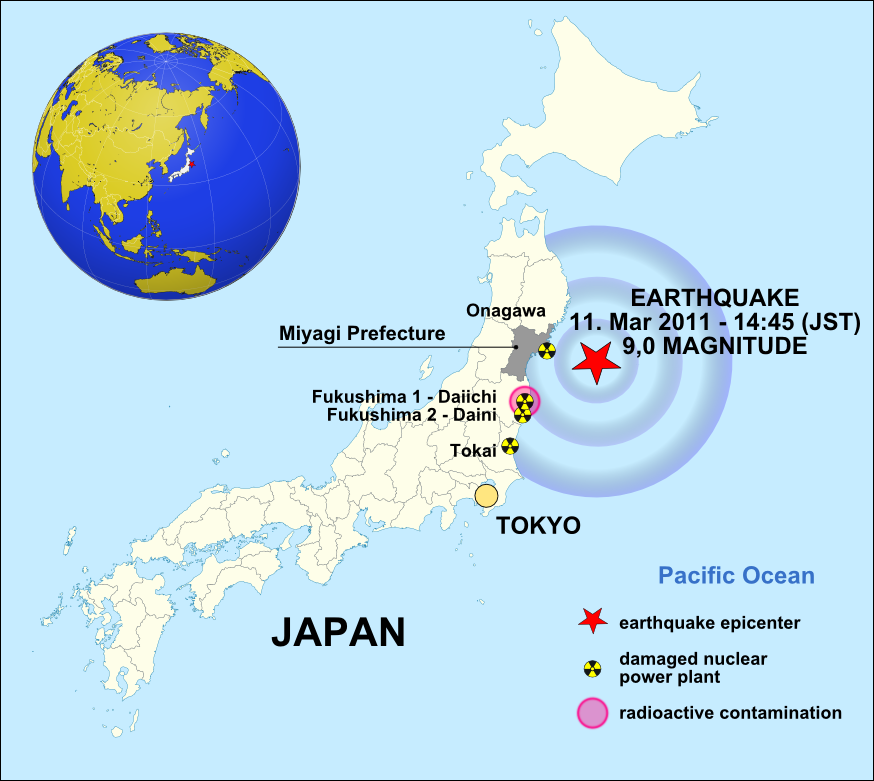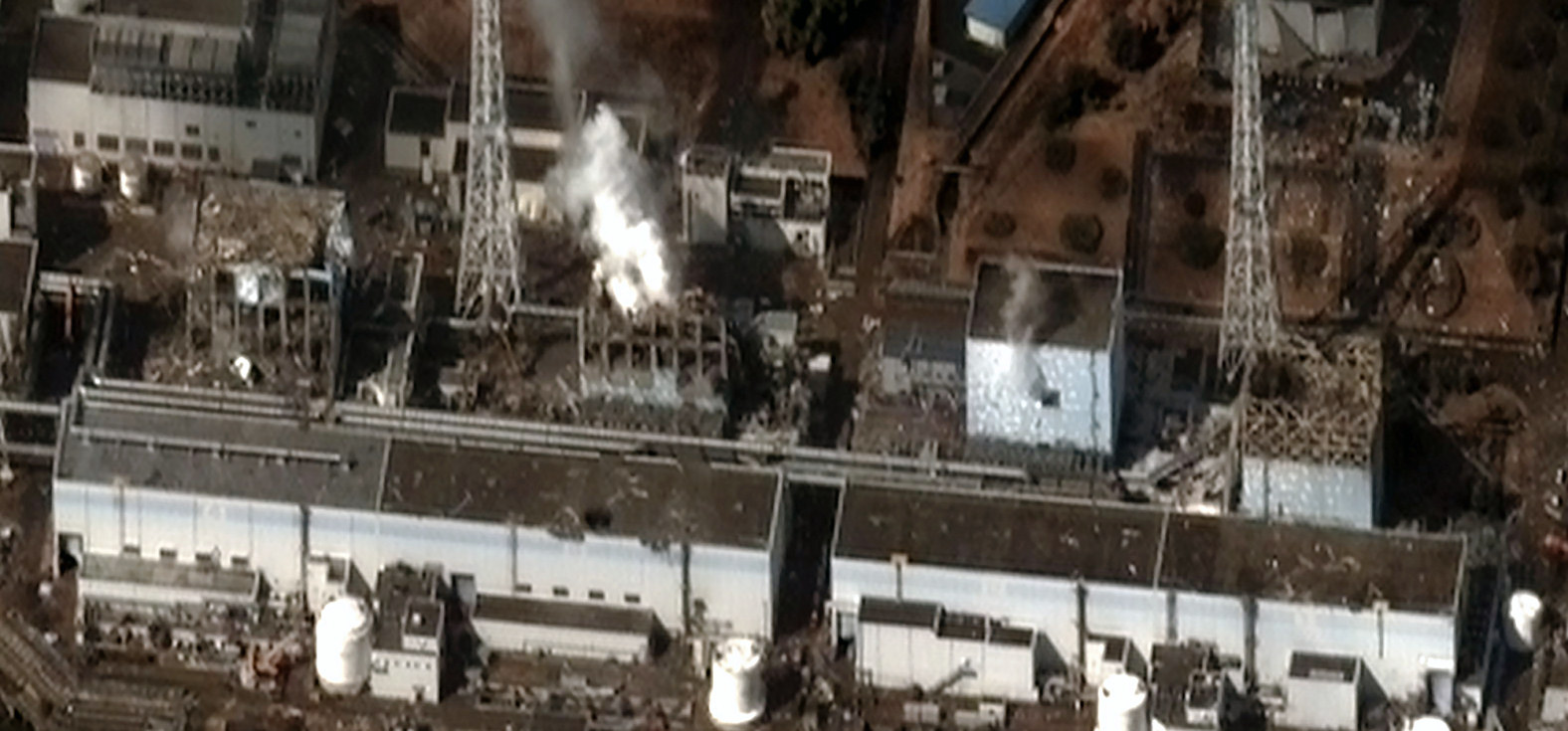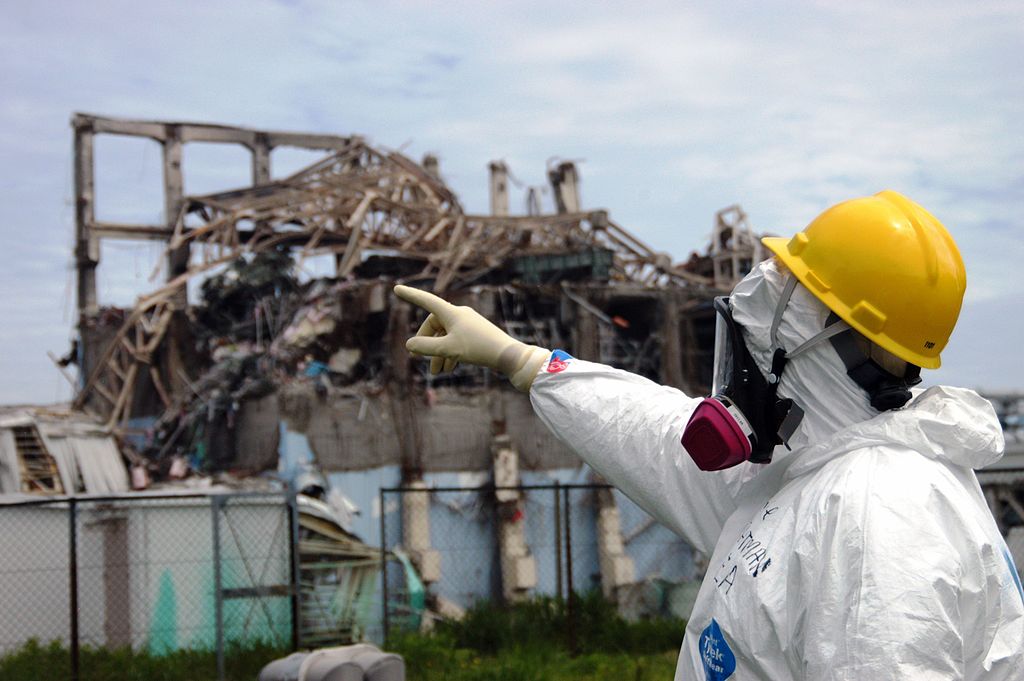Fukushima, Japan —(Map)
March 11, 2011 was a terrible day for Japan. Natural disasters led to a man-made disaster that the country is still dealing with. Today marks 10 years since a tsunami triggered the world’s worst nuclear disaster since 1986.
On that afternoon, the most powerful earthquake in Japan’s history struck in the sea off the country’s east coast. The 9.0 magnitude earthquake caused a series of tsunamis to pound Japan’s east coast. About 18,000 people were killed by these tsunamis.

(Source: Maximilian Dörrbecker /Connormah/W.Rebel [CC BY-SA 3.0], via Wikimedia Commons.)
But the tsunamis brought other problems, too. The Fukushima Daiichi Nuclear Power Plant is built right at the edge of the ocean in the town of Ōkuma, in the Fukushima district. The plant creates nuclear energy.
Nuclear Energy
Nuclear power is created by splitting atoms in a nuclear reaction – the same science behind nuclear weapons. Nuclear power produces toxic waste which must be handled and stored with great care.
The great danger of nuclear power is radiation. If something is “radioactive” that means it gives off radiation. Radiation is energy traveling in waves. High levels of radiation can cause sickness or even death. It can also affect the DNA of humans and animals.
Because nuclear reactions create huge amounts of heat, the nuclear reactors where the reactions happen need to be constantly cooled.
For safety, the Fukushima power plant was shut down as soon as the earthquake was detected. When the electricity went out, the factory had to count on its backup electrical generators to cool the reactors.

(Source: Digital Globe [CC BY-SA 3.0], via Wikimedia Commons.)
But when a 46-foot (14-meter) tsunami wave washed over the plant, its backup generators stopped working, too. The flooded reactors slowly began to overheat. Over the next few days, three of the factory’s four reactor cores melted down, and there were three large explosions.
Radiation began to escape from the plant. The government closed off an area within 12.5 miles (20 kilometers) of the plant. Over 150,000 people were forced to leave their homes.

(Source: Greg Webb, IAEA Imagebank [CC BY-SA 2.0], via Wikimedia Commons.)
That was ten years ago. Since then, Japan’s government has spent over $300 billion recovering from the earthquake, tsunamis, and the nuclear accident.
Some areas around the Fukushima plant are still closed, but much of it was re-opened a few years ago. Scientists from the United Nations say the radioactivity from the disaster isn’t likely to cause future health problems for people in the area.
😕
This image has not been loaded because of your cookie choices. To view the content, you can accept 'Non-necessary' cookies.
The government closed off the area around the plant. Over 150,000 people were forced to leave their homes. Some areas around the Fukushima plant are still closed, but much of it was re-opened a few years ago. Above, one of the closed-off areas in 2016.
Still, most people who used to live in the area haven’t returned. In 2019, the company that owns the power plant decided to close it permanently. Cleaning up the site is expected to take 40 years.
The group Greenpeace, which works to protect the environment, says radiation levels are too high in many of the re-opened areas. The group says the region can’t be returned to normal.
😕
This image has not been loaded because of your cookie choices. To view the content, you can accept 'Non-necessary' cookies.
In 2019, the company that owns the power plant decided to close it permanently. Cleaning up the site is expected to take 40 years. The huge piles in this picture are radioactive dirt that has been collected as part of the cleanup effort.
One big question about the cleanup is where all the radioactive material will go. That’s a problem faced by any nuclear plant. The Fukushima plant has an extra problem. There’s so much radioactive water at the plant that there’s not enough room to store much more.
The government says it has filtered most of the radiation from the water and plans to release the water back into the ocean. Fishermen, and groups like Greenpeace don’t like that idea. They’re afraid the radiation will harm sea life, and sooner or later make its way back to humans.
😕
This image has not been loaded because of your cookie choices. To view the content, you can accept 'Non-necessary' cookies.
One big question about the cleanup is where all the radioactive material will go. There’s so much radioactive water at the plant that there’s not enough room to store much more. The government says it plans to release the water back into the ocean.
Though the Fukushima Daiichi disaster happened 10 years ago, its effects continue today, and will be felt far into the future.
Did You Know…?
Many people believe nuclear energy will be an important tool for fighting the climate crisis. When nuclear power works correctly, it creates far less air pollution than coal or oil. But nuclear power always produces radioactive materials. The question is whether humans can safely control, store, and contain these materials, even in the face of huge, unexpected natural disasters.
😕
This map has not been loaded because of your cookie choices. To view the content, you can accept 'Non-necessary' cookies.
